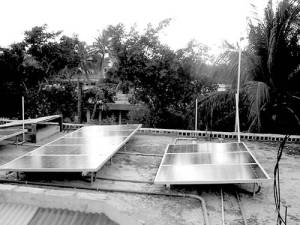Earth Notes: Lessons from the Third World

SOLAR PANELS power a clinic operated by Ipswich, Mass.-based Partners in Development outside Port au Prince, Haiti, where Saint Joseph’s College students served last week.
By Frank Daggett
It’s ironic that the poorest country in the Western Hemisphere is in some respects ahead of the richest, most technologically advanced nation on the planet.
Last week in Haiti, I accompanied a team of 12 students and three faculty members, who rang in the New Year assisting in a medical clinic, laying a house foundation, and providing expertise in developing budget spreadsheets, job descriptions and other administrative tools in the ongoing work of helping the people in a small village on the outskirts of Port au Prince lift themselves from the dust of bone-crushing poverty.
The juxtaposition of advanced and backward, Space Age and Bronze Age, creates an other-worldly feel. A man living in a tin hovel checks his iPhone. Women balance on their heads five gallon buckets of water, drawn from a hand-operated pump, lit at night by a modern streetlamp powered by a solar panel. The brightly colored words painted on a cinderblock shack announce items for sale, including Coke and phone cards, and that it’s also a cyber café. In front, an old woman cooks food on an open fire. Goats, chickens and dogs so thin you can see their ribs wander freely, the whole scene watched over by a tower with various antennae and satellite dishes.
In the clinic, diseases long ago eradicated from the modern world are treated using state-of-the art diagnostic equipment powered by rooftop solar panels.
Haitian industriousness and resourcefulness is simply amazing. In the year since my last visit, most signs of the 2010 earthquake have vanished. The rubble has been collected and by pickaxe and sledgehammer worked into the mix of new concrete and cinder block. A small plot behind a house grows mangoes, bananas and onions. (Fresh mangoes for breakfast, al fresco on New Year’s Day — what a treat! especially when it’s in the single digits in Maine, as my Haitian friend sees on his phone — mine has no service outside the United States.) Shredded plastic shopping bags and soda bottles form colorful displays on lines across the main street. I’ve come to this village at the time when their environmental impact is the greatest, when Christmas lights are hung from some homes and shops. It’s surprising how festive a single string of maybe 40 colored mini-lights can be in a village where most homes are lit only by a single bulb — a CFL, by the way, a single CFL in the family room, light for a couple of hours in the evening, as the family shares its one substantial meal of the day — all ingredients from within five miles, most within yards of the cooking pot.
Packaging waste is practically non-existent; fruits are carried in bags, rice and chunks of meat wrapped in cloth. No one owns a car. Everyone either walks or takes a bus. The brightly colored buses aren’t air-conditioned, and though their well-maintained paint jobs make them appear new, they’re mostly old school buses from the States — we passed one still bearing its “Wells-Ogunquit School District†livery.
Seeing first-hand how these people live, how content they are with a lifestyle that takes little from the planet, that provides joy and fulfillment beyond all expectation, the alarm sounded by some in this country about the environmental impact of the developing world is exposed as a thinly veiled attempt to preserve the consumptive lifestyle many of us have come to demand as our entitled standard of living. Instead, we need to take reduce, reuse and recycle to whole new levels.


